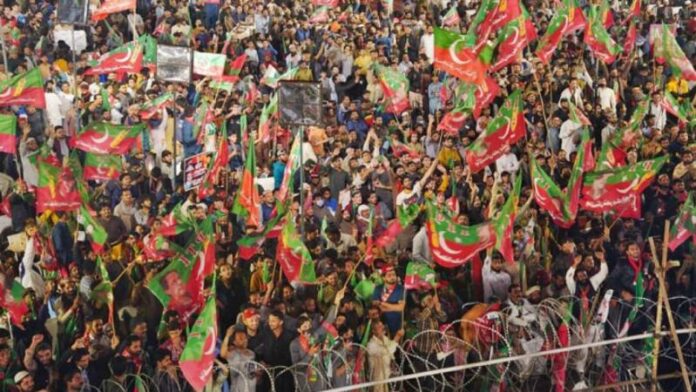The government’s decision to ban the Pakistan Tehreek-e-Insaf (PTI) will again land in the Supreme Court of Pakistan. As many as 10 judges of the court have recently declared PTI to be a legitimate party despite being stripped of the bat-symbol for the purpose of 2024 elections. Then why has the government taken such a bold measure as banning the PTI if the prospects of succeeding are negligible? The answer is that perhaps it is a thought-through plan.
Regardless of the merits and context, the Federal Government avails this authority under Article 17(2) of the Constitution read with Section 212(2) of the Elections Act 2017. Undoubtedly, they are trying to eventually invoke Section 213 of Elections Act and disqualify PTI MNAs and MPAs from national and provincial assemblies respectively. From contesting the reserved seats alone, the government wants to annihilate PTI from the Parliament altogether.
Moreover, the government is well aware that the recently enacted Supreme Court (Practice and Procedure) Act 2023 mandates that the benches at the Supreme Court are to be constituted by a three-member committee. One may hope that the bench that will hear the reference under Article 17 will be constituted without undue disagreements among committee members. Despite being an internal matter of the Supreme Court, any potential disagreements may give the government a chance to further politicize the case as well as the bench even before commencement of the reference. Once initiated, this reference will most likely result in yet another lengthy litigation in the apex court. Unlike advisory jurisdiction, the decision of the Supreme Court in such a reference holds finality with far-reaching consequences on democracy.
Importantly, the PML(N)-led government has already announced it will file a review petition against the reserved-seats judgement. It is pinning its hopes on serious “lacunae” in the larger bench’s decision. The review petition in the reserved seats case and the reference to ban PTI, will likely have a strong bearing on each other. For some political analysts, this move by the government may merely be a means to influence the larger bench in the review petition, if any. However, constitutionally, it is true that the Supreme Court is to soon find itself in a difficult spot apart from obvious reasons.
As per Supreme Court Rules of 1980, the review petition may be filed within 30 days of the Supreme Court’s decision whereby the reference to ban a political party has to be within 15 days as per Constitution. Strategically, it suggests that the government may file reference to ban PTI prior to the review in the reserved seats case. The same documents and evidence that the government may present in the reference before the Supreme Court related to the foreign-funding, cipher, May 9 and treason cases may be used to meet the criteria of “fresh evidence”-as required for a review petition under the Supreme Court Rules.
Another apprehension, though not indicated by the government yet, is that the government may attempt to pack the Supreme Court with more judges. Article 176 plainly allows Parliament to determine the number of judges through an Act of Parliament, and the same has happened in many countries with a divided apex court. The government, with support of political allies, may consider increasing the numerical strength of Supreme Court judges through the Parliament under the garb of “judicial reforms” or high pendency of cases in the top court. Getting such a law through Parliament is likelier for the government until the reserved seats allotted to the PTI are actually filled in Parliament.
If manifested, this would not be a new phenomenon in the parliamentary history of even one’s own country. Considerable attempts have been made in the past to increase the number of judges in the Supreme Court. In 2016, Babar Awan (then affiliated with PPP) as Senator moved a Bill demanding “one fourth of the total number of judges of the Supreme Court shall be women”. The said Bill was opposed by the government on grounds that Article 177(2) did not distinguish the appointment of Supreme Court judges on the basis of sex and/or gender. Again, in 2023, Senator Fawzia Arshad, belonging to PTI, made an attempt to pack the Supreme Court under the auspices of Article 176. This was done under the garb of women’s representation, demanding the total number of judges be increased to 18, including on -woman judge.
Generally, a review petition in the Supreme Court is decided by the same bench as heard the original case, both in terms of the judges and the numerical strength, as laid down under the Supreme Court Rules as well as apex court’s recent judgements. However, the condition of “as far as practicable” is applicable while constituting the bench for a review petition. Therefore, theoretically, the review petition in the reserved seats may be put before a full bench with the new incumbent judges as result of court-packing- albeit this likely sounds too far-fetched and assumptive. Further, with the recent decision of the Supreme Judicial Council (SJC), a constitutional body, to appoint four ad hoc judges in the apex court under Article 182, the chances of review petition in reserved seats (and PTI ban reference case as well!) being put before a larger bench have increased more than ever.
Banning political parties endanger federation and often fail to suppress political ideologies. Such a reference before the Supreme Court will be the first such precedent in the constitutional history of Pakistan. Where the Supreme Court will get an opportunity to develop new jurisprudence on Article 17, the apex court will be carrying the burdens of democracy on their shoulders.
However, the Supreme Court may not be the last hope of the government in achieving this plan. Another avenue for achieving the same objective probably lies in the Anti-Terrorism Act 1997. It was not long ago that the PTI government had used this law to outlaw a right-wing political party, TLP. The law not only gives wide range of definition of “terrorism”, but also seems to encapsulate political parties in the meaning of an “organization”. Section 2(P) states, “organization means any group, combination or body of persons acting under a distinctive name.” Moreover, this naturally implies that any such move to implicate and ban the PTI under the ATA would be decided not by the Supreme Court, but by a judge of an ATC.
It appears that the government is getting hard after the PTI, and is not willing to let go the reserved seats like a piece of cake. However, during the course of executing the ‘ban plan’, the government must exercise caution, restraint and refrain from any political gimmicking and experimentation. The distant and recent pasts alike suggest that banning political parties endanger federation and often fail to suppress political ideologies. Such a reference before the Supreme Court will be the first such precedent in the constitutional history of Pakistan. Where the Supreme Court will get an opportunity to develop new jurisprudence on Article 17, the apex court will be carrying the burdens of democracy on their shoulders.























